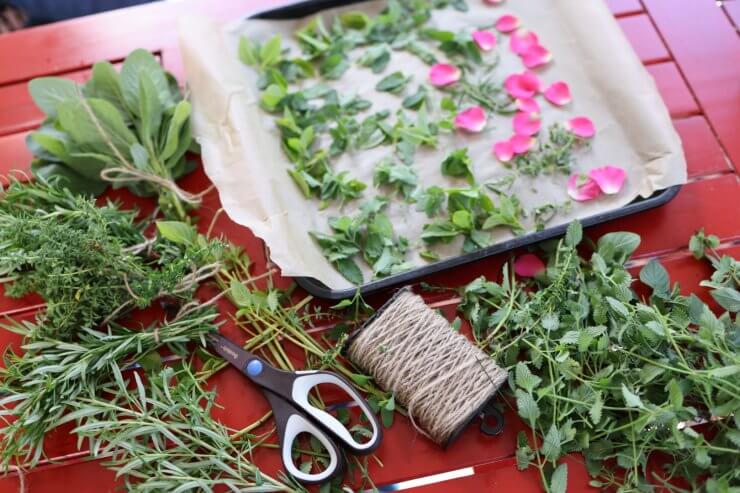
If you were to ask me what part of my garden I love most, I’d emphatically tell you it’s my herb garden. When people visit my backyard, it’s the first thing I love to show off, and I’ve planted it on the pathway to the back door so that anyone coming to visit will get a little infusion in the air as they walk by.
Throughout the spring, summer, and fall, I use lots of fresh herbs in my cooking, but there’s always still plenty to go around. Sometimes I make herb bouquets and hand them off to neighbors or anyone who wants them, or maybe I’ll make a little fairy crown for my daughter, but ultimately the majority of them get dried and saved for later.
Before we get into drying herbs, let’s first talk about how to harvest them.
Harvesting Herbs
Harvest in the morning to get the most flavor.
With leafy herbs (mint, lemon balm, thyme), it’s best to harvest leaves right before the plant flowers. This is when they have the most oils and flavor in them. You can also harvest in the fall after flowering, they may just be a little less potent.
When it comes to flowering herbs (lavender, chamomile, rose), aim to harvest mid-bloom, before the flowers begin to droop.
I like to use small, sharp, clean scissors for harvesting the leaves and flowers. A general rule is to harvest about 5% of the plant. By trimming your plant regularly, you are encouraging new growth.

Preparing Herbs
After you harvest them, remove any old leaves because they won’t have much flavor. Also remove any diseased, spotty leaves or any leaves with major blemishes.
Once trimmed and pruned, rinse the herbs under cool tap water and dry gently with a paper towel. Do not rub them dry.
Drying Herbs
You can bundle different herbs you want to dry, but in general, I like to separate them. If you’re making tea or a spice blend, you might want to measure how much of each goes into the mix, which is another good reason to separate different herbs as you dry them.
The hanging method (best for oregano, thyme, parsley, and rosemary): A picture of herbs hanging in a bundle from a basement wall is usually what comes to mind when most people think of hanging herbs, but it’s more nuanced than that.
- Find a dark but well-ventilated dry area, about 70-80°F, where you plan to dry your herbs. A basement can work, but only if you have a running dehumidifier, or the herbs won’t dry out, they will simply mold. Spring a line across the area where you plan to hang your herbs.
- Create small bundles, about 8-10 sprigs per bundle, and wrap twine or string around them.
- Use small hooks to hang each bundle. Make sure herbs are completely dry before storing, then remove stems, crumble, and store them in an air-tight container. Depending on your location, the dehydration process can take a couple of weeks.
Hack: To keep your herbs from getting dust and debris on them as they dry, take a paper bag and cut a few large holes throughout (see video) and wrap that loosely around each bundle of herbs as they dry.
Notes:
- High-moisture herbs, like mint, tarragon, and basil aren’t ideal for the hanging method, they are more prone to mold.
- Keep any hung herbs out of the sun as well, as the flavor and aroma can wane in the sun.
The oven method:
- Wash and pat dry your herbs with a paper towel.
- Bake them in the oven on parchment paper at your oven’s lowest setting (ideally 170°F) for 15 minutes, rotate the pan, then another 15 minutes or until completely dry.
- Remove stems, then crumble into an air-tight jar and store.
The dehydrating method:
- Preheat dehydrator to 95°F to 115°F.
- Place clean herbs in a single layer on the dehydrator trays.
- Make sure all the herbs have enough airflow and remove any extra trays if not.
- Dry anywhere from 1-4 hours. They are dried when they crumble easily.
Saving Dried Herbs
Store herbs in air-tight jars away from the light. Stored this way, they can last six months to a year before they deteriorate.
To preserve flavor longer, you can also wait to crush the herbs until you plan to use them.
Have you ever tried to dry herbs before? What are your tips? Let me know in the comments.


 Previous
Previous


I’d like to know the pros and cons of drying in the microwave
You can dry herbs in a microwave by laying them in a single layer on paper towels, covering them with another paper towel, and heating on high for 30 second intervals until they become brittle and crumble easily. You’ll need to monitor them closely for burning and continue with short bursts of power until the herbs are fully dried.
While this method can be very quick, you could be sacrificing flavor, color and texture. Rapid heat can cause the essential oils to evaporate, greatly impacting flavor.
I’ve heard that some people prefer to freeze fresh herbs in ice cube trays filled with water. Once frozen in water, the herb filled ice cubes are stored in ziploc bags with labels. When ready to use, ice cubes are taken out and the water melted away. How does this method fair in terms of preserving taste and quality?
Freezing in ice cube trays with water or oil is a great way to preserve fresh herbs. You probably won’t want to use them as a garnish but they’ll be delicious for soups, stews and sauces.
Good info. Thanks!!